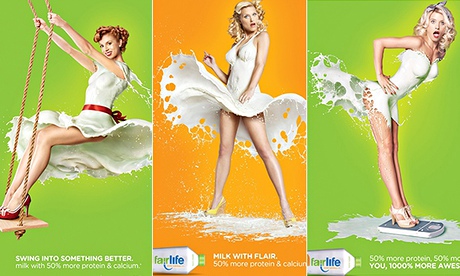
You know something’s up when images of the type associated with the sexism of past decades resurface in a thoroughly modern advertising campaign. So it was with a sigh that I read the news about Fairlife,Coca-Cola’s new “premium milk brand” (nope, me neither), illustrated with images of naked women covered in flowing milk. The pictures – from period-styled hair to looks of arousal and “naughty surprise” – are clearly designed to evoke retro “pin-up girl” images. One loosely mimics the infamous Marilyn Monroe up-skirt moment. As if the implications of the slender, long-legged images weren’t clear enough, another features a woman perched atop a set of scales (in high heels, obviously – isn’t that how everybody weighs themselves?)
The ads, seemingly based on an existing set of photographs by London-based photographer Jaroslav Wieczorkiewicz, raise more questions than they answer. Is this milk for drinking, or are you just expected to pour it lavishly over your head as you sit at the breakfast table, pouting sexily at your dry cereal? Why don’t men seem to be invited to partake in this new gastronomic experience? And given the enormous levels of dairy wastage likely to ensue, can you really justify charging double the price for it compared to normal milk?
Joking aside, seeing these images of women’s bodies being used, once again, to advertise an unrelated consumer product (“Drink what she’s wearing”) is a tedious reminder that when it comes to the objectification of women in advertising, we seem to be slipping backward instead of moving forward. Yes, there’s a tenuous argument to be made that the link is valid if the milk is being promoted as healthy and good for your body, but that doesn’t explain the sexualisation of the women, nor the lack of any male counterparts.
This is just the latest in a never-ending stream of examples of women’s bodies used as advertising fodder with scant regard for relevance or originality. Examples are tweeted to the Everyday Sexism Twitteraccount with depressing regularity. Want to promote a new games console? Why not use a headless woman’s body with two pairs of breasts? Advertising a restaurant? What you need is a picture of anaked woman covered in spaghetti! Trying to spread the word about green electricity? Go for a picture of a sexy woman with a lightbulb in her mouth. Decorating a van to spread the word about your curtain and blind business? Don’t forget to pop a lingerie-clad model on there! And everyone knows nothing says “LED technology” like an enormous picture of a woman’s naked arse.
Some particularly egregious examples combine racism and sexism, as in the case of the recent tweet from Magnum South Africa (swiftly deleted), used to advertise its new “pink and black” ice creams. The tweet featured a picture of a white woman’s heavily made up face next to a black woman posing in a corset, with the ice creams displayed beneath them. It read: “A sultry espresso ripple covered in dark chocolate or creamy pomegranate indulgence?” The company later explained the withdrawal of the ad, but it didn’t stop others following suit with similar imagery.
These images often seem to involve very little thought, and clearly come from the old “sex sells” school of marketing. They create a daily wallpaper of objectification that sends a powerful message about the function, availability and disposability of women’s bodies. This isn’t about a prudish desire to censor nudity, but an impassioned plea to give authority and control over women’s bodies back to women themselves, instead of seeing pieces of them plastered across billboards as lifeless and cynical props to draw attention to a parade of products.
And in some cases, this tactic can have a wider impact. During a recent period of renovation, Manchester’s Malmaison hotel chose to cover its hoardings with images of women in heavy makeup, emergency tape wrapped around their breasts, gazing suggestively at power tools. As Jeanette Winterson rightly pointed out, far from “harmlessly” spicing up the building area, such images actively sent the message that women are unlikely to be competent builders or engineers – their job is simply to please the eye.
Laudably, Malmaison took action to cover the hoardings after receiving complaints, a step that suggested we are moving forward when it comes to challenging the gratuitous exploitation of women’s bodies for impact and sales. That progress makese the new Fairlife adverts, in their tedious predictability, yet more frustrating. The fact that they even use retro-style images feels like a mocking reminder that, several decades on, we have not made much progress away from the concept that women’s bodies are objects for commercial consumption (a frustration tempered only slightly by the perceptive wag on Twitter who pointed out that one of the images looks suspiciously as if the model is actually farting milk).
Isn’t advertising supposed to be original? Isn’t a new campaign supposed to be all about surprising consumers and capturing their attention with new and innovative ideas? If so, then surely semi-naked women, the single most over-used advertising gimmick on the planet, is no longer the way to go.
And yes, the first person to mention the Diet Coke advert in the comments section gets a gold star. Ready … Set … Go!

No comments:
Post a Comment